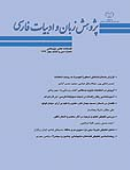ریختشناسی تطبیقی قصّههای ماهپیشانی، یهشین و سیندرلا
محورهای موضوعی : پژوهشهای ادبیات کلاسیک ایران
1 - دانشیار گروه زبان و ادبیّات فارسی دانشگاه پیام نور
کلید واژه: قصّه ریختشناسی پراپ ماهپیشانی یهشین سیندرلا,
چکیده مقاله :
پژوهش های تطبیقی در حوزة ادبیّات عامیانه و ادبیّات کودک می تواند با تبیین مشابهت های فکری و فرهنگی مردم جهان، زمینه ساز رشد اندیشه های بلند انسانی گردد. در پژوهش حاضر، نویسنده با بهره گیری از نظریّة ریخت شناسی «پراپ» به تبیین و تحلیل ساختاری قصّه های «ماه پیشانی» از ایران، «یه شین» از چین و «سیندرلا» در غرب می پردازد. از آنجا که قصّه های بررسی شده در این پژوهش از خانوادة قصّه های پریان هستند، با الگوی ریخت شناسی پراپ که برآمده از تحلیل قصّه های پریان روسی است، همخوانی زیادی داشته اند. نویسنده پس از تطبیق مشابهت های ساختاری این سه قصّه، به یک ساختار مادر دست پیدا می کند که برآمده از خویشکاری های همسان هر سه قصّه است و طرح داستانی هر سه قصّه بر پایة آن است. برای تعیین نسبت دیرینگی این داستان ها در مقایسه با یکدیگر، نویسنده ناگزیر دست به یک تحلیل فراساختاری زده و یک کهن الگوی بسیار شناخته شده در قصّة ماه پیشانی را، پس از بررسی به عصر پارینه سنگی (عصر شکار) رسانیده است. نویسنده سرانجام نتیجه می گیرد که روند دگرگونیهای ساختاری این سه قصّه، نزولی بوده است؛ یعنی قصّة ماه پیشانی، روایت کهن تر این قصّه ها بوده و در گذار زمان، از تنوّع شخصیت ها و شمارگان خویشکاری های آن کاسته شده، تا جایی که نمودگار ریخت شناسی قصّة سیندرلا، همان نمود گار مادر برآمده از قصّههای تطبیق داده شده در این پژوهش است.
Comparative studies in folk literature and children’s literature can pave the way for the growth of human lofty thoughts through explaining the ideological and cultural similarities among the people of the world. In this research, using Propp’s morphology theory, the author explains and analyzes the structure of an Iranian tale “MahPishani”, a Chinese one “Yeh-Shen”, and “Cinderella” as a Western tale. Since the tales studied in this research are from the fairy tale category, it is quite consistent with the Prop’s morphology model which is the result of Russian fairy tales analysis. After matching the structural similarities of the three tales, the author proposes a proto structure (mother structure) which is derived from the common functions of the three tales upon which their plots are based. In order to find out which tale is the most ancient one, a meta- structural analysis was inevitable. The analysis reveals that the very well-known archetype in MahPishani goes back to Paleolithic Age (Hunting Age). Eventually, the author deduced that the structural changes in these three tales follow a descending pattern, i.e. “Mahpishani” is the oldest narration, and over time, the diversity of characters and the number of functions have been decreased to the extent that the morphological diagram of Cindrella tale is the same as the mother diagram derived from the comparison of these three tales.


